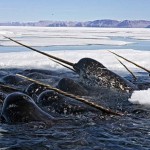“Unicorns of the Sea” Investigated by Scientists
Many wonders of the natural world remain to be a mystery due to limited explorations so far by scientists including the animals in the lesser explored regions of our oceans. One of those creatures included the Monodon monoceros or the narwhal, a tusked whale-like mammal but seems to be very strange. Statistics shows that worldwide population of narwhals, known as the unicorns of the sea, is estimated between 50,000 to 80,000. The majority of these creatures live in the icy and cold Arctic waters of Greenland and Canada.
Scientists hope to learn more about these creatures, their behaviors and how they interact with their environment. A team of 15 researchers had already placed 9 tracking devices late last summer to 9 narwhals in an effort to track and study these animals. The devices fitted to 9 narwhals will broadcast the narwhal’s movement and location every 4 days via GPS Technology.
The interval and turnaround time of 4 days was chosen in order to prolong the battery life while getting information about the dynamic picture of the narwhal’s movement and behavior. Out of the 9 original narwhals fitted, 7 still remains to transmit data via the tracking devices mounted at the dorsal blubber of the narwhals. As of the latest data gathered, the narwhals are migrating south as the North Baffin Island’s sea will be covered by ice.
